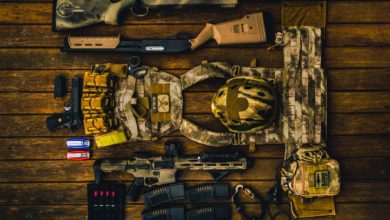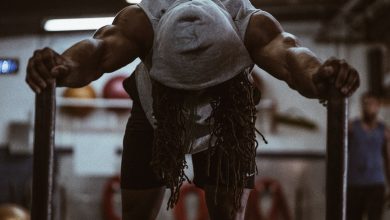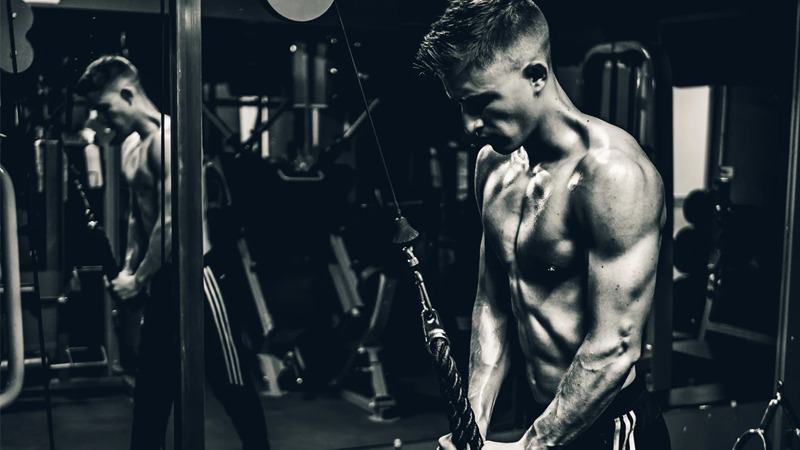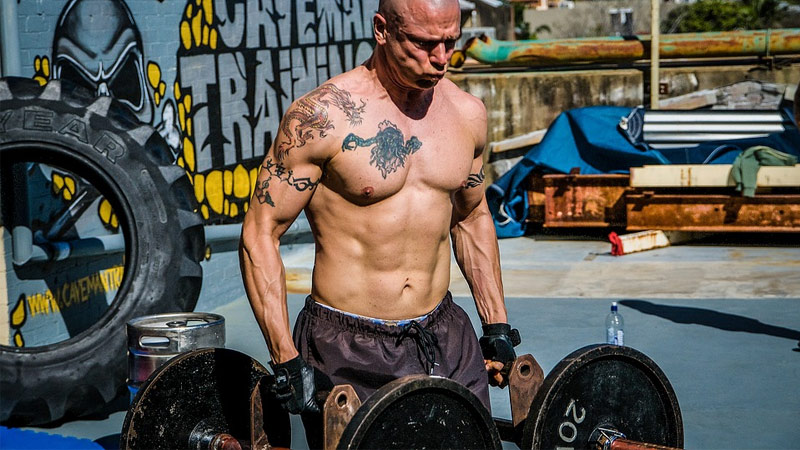
Farmer walks are the simplest exercise a man can do. All you gotta do is grip, rip, and walk your way to a multitude of gains. In a world where we’re constantly looking for new innovative ways to train easier, they tell us to turn back and go harder. So, let’s look at how loaded carries could change your game one callous tearing step at a time.
Farmer Walks – What are they?
In their simplest form farmer walks are a loaded carry. You pick up the load, walk a set distance, and then put it down again. There are many variations to challenge the body in different ways and alter the stimulus, but the primary principle stays the same.
If you’ve ever tussled or grappled somebody who carries things for a living, you’ll know how god damn strong they are. When many are sat comfortably in cubicles tapping away at keyboards, these guys are consistently inflicting contractual tension across their whole body.
If you were to equate their total daily volume of lifting into a workout program, it’d likely blow most of ours out of the water. Imagine the number of reps and sets a stereotypical farmer or construction worker smashes in a day. Every loaded step adds to their already elevated level of functional fitness.
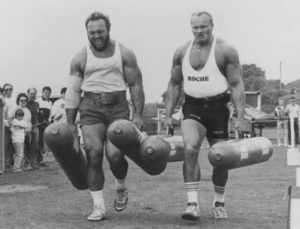
So, it makes sense to implement carrying into strength training, right? Well for years the farmer walk was strictly reserved for the realm of Strongman Competition. Instead of actual farmers carrying two full buckets, behemoths with chalky bellies and monumental muscle paraded on TV with heavily loaded handles, trapped tightly inside their vice-like grip.
Today though, we’ve seen the light and use loaded carries as an essential tool for athletic development. The infamous strength coach Dan John says he can change your life in three weeks just by using farmers walks alone.
Hell, if hypertrophy is your game, hitting them will eventually leave you with the shredded torso and traps of a rodeo bull. During a loaded carry, your entire body must work synergistically to stay strong, meaning you can work multiple muscle groups in just one exercise.
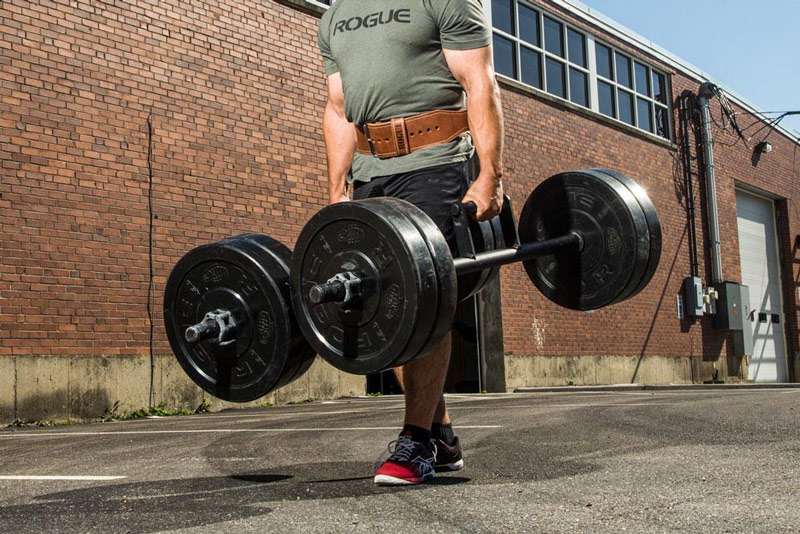
Full body benefits
According to the legendary Dan John, ‘Farmer walks can be the answer to issues from getting leaner to adding work capacity. They are a game changer for most athletes.” Here’s a rundown of the muscle groups hit:
- Core – brace to support the spine
- Back – works with the core to support the spine
- Shoulders – keeps the girdle pulled back and posture upright
- Arms – fights against gravity to keep the weight in the air
- Legs – propels the entire body and added load forward
Just by drilling farmer walks alone you can reap a bucket load of benefits. When performed regularly you can expect improvements in:
Grip strength – Gripping and ripping loads for an extended time gives your forearms a thorough thrashing. Squeezing the handles passively works the finger flexors through isometric contraction, meaning you’ll be able to crush a man’s hand in a single shake and handle higher weights in the training room
Core bracing & back strength – Whilst farmer walks will scorch fat, leading to etched abs, the benefits aren’t just superficial. The core muscles must brace beyond belief to support the spine and protect it against shear and compressive forces. Plus, deeper stabilizing muscles surrounding the spine are forced to make tiny micro-adjustments during every step to ensure safe posture is always kept
Posture – Staying safe during farmer walks with heavy weights is all about posture. By keeping the head held high, spine in neutral and chest up, our postural muscles become developed to handle higher loads. When hitting big moves like squats and deadlifts you’ll be better equipped to smash serious numbers with confidence
Proprioception – Functional movements such as walking allow us to constantly adapt and improve proprioception. Equilibrium, balance, and positioning are all tested when chugging between A to B with 1.5x our body weight hanging from burning forearms.
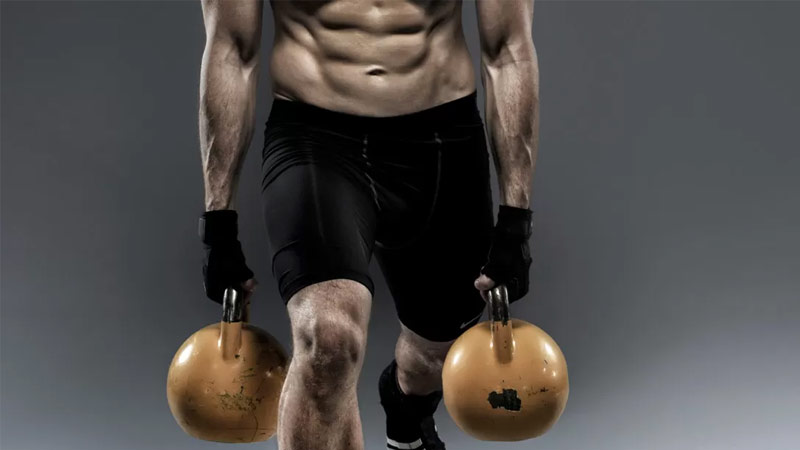
Overall strength and hypertrophy – Without maintaining tension through our entire being we’d never make it past the starting line. Continuous concentric and isometric contraction allows our upper body to hold fast, whilst our wheels of steel do their part, transporting us via eccentric and concentric contraction. These contractions create muscle tears, leading to potential developments in both strength and hypertrophy
Grit and mental determination – Anybody can hit a few leg presses and act their way through a ‘hard’ workout. But it takes sheer blood, sweat, and tears to carry heavy AF objects while gravity is trying to drag them from your shaking hands. Working your way up to heavier weights over longer distances tests your mental metal and conquers any inner bitch like nothing else
Fat burning – Nobody said a fully loaded farmer carry is easy. As an intense exercise, your body will scorch through calories to find the energy for every grueling step. If your goals are to lean up without wasting muscle by trudging away on a treadmill, look no further
How to farmer walk
As much as we keep talking about simplicity, a solid farmer walk is a finely tuned thing. Get it right and you’re in for a world of gains, whereas if you get it wrong you could be in a heap of pain.
Just like all lifts, loaded carries should be respected and learned correctly. Nailing your form will keep you in the iron game for longer and lead to overall bigger lifts.
Steps for performing perfect standard farmer walks:
- Set yourself stood-up with two weights on either side. These could be dumbbells, kettlebells, barbells, specifically designed handles, or a trap bar
- Grab a weight in each hand. Aim to grip the middle to level out the load
- Stand up as if hitting a deadlift by bracing the core, keeping the chest proud, spine aligned, and driving through the heels
- Think ‘tall spine’ here. Straighten your back, look ahead, keep the core braced and ensure the neck is in a neutral position. Once your posture is perfect you’re ready to move
- Use small steps as you walk forward. Maintain a proud posture and keep the core braced
- You’re walking for the full distance here so don’t drop the weights until you reach the end
- Safely put down the weights under control. Don’t go bashing ankles or arching your back for the sake of a second more work

What weight you should use
Establish load in relation to distance, bodyweight, or by using progressive overload.
For shorter sprint style walks between 10-15 meter go for a heavier carry at 1.5x bodyweight. This should feel like you’re almost maxing out, but without crumbling like a pencil-necked newb.
Alternatively, use 1x bodyweight for anything between 15-30 meter. These middle distances are all about building both strength and endurance.
Finally, shoot for 0.5x bodyweight for longer distances. These are the 30+ meter slogs you’ll be pursuing for extra endurance training, which are great to smash in a spacious parking lot.
As you get stronger and fitter you can always add more weight using the progressive overload principle. Step up in small increments at a time up to around 10%.
Final bro tips:
- Because loaded carries can be extremely energy draining and intense, perform farmer walks as a finisher. If you include them at the start of your workout any remaining lifts might suffer
- Form is everything in weight training. It’s more important to keep posture proud than to rack numbers – nobody makes gains when they’re injured
- To really challenge your proprioception and improve balance, walk around cones and/or change direction
- Dig deep, bro. Embrace the grind and build mental toughness every step of the way
- Tailor-made carry handles are awesome because you can use bumper weight plates. This makes standing up and loading a higher amount of weight much easier
Hungry for more muscle knowledge? SpotMeBro have got you covered:



